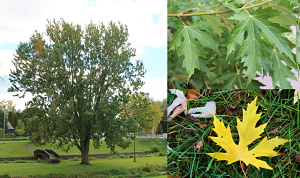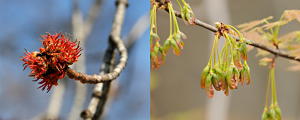The silver maple is a member of the soapberry (Sapindaceae) family. The Genus Acer comes from the Latin name for maple tree while the specific epithet saccharinum means sugary in reference to its light, semi-sweet sap (although syrups made from the silver maple are much less sweet than those made from the sugar maple)!
That said, syrup isn’t the only thing the silver maple has to offer! Like its many common names, it also has many uses. The bark was pounded to make flour for bread, the seeds were often roasted with butter and salt and eaten as a tasty snack, and the sap was used as a cough syrup and to cure kidney and liver ailments. This silver maple is also one of Ontario’s very few native trees that have a fast enough growth rate to be considered for biofuel production. Additionally, its strong and versatile nature allows it to tolerate a wide variety of soils and urban conditions such as compaction and pollution and its wide climatic range allows it to successfully grow as far north as Manitoba and as far south as Florida!

A Silver Maple climatic distribution map.
Reaching an average mature height of about 50 feet and an average mature width of about 35 feet in urban settings, the silver maple is one of the largest deciduous trees native to Ontario. Its oval to rounded crown and graceful drooping branches make it an excellent urban shade tree. Simple, opposite, deeply five-lobed leaves emerge in early spring with coarsely serrated edges, a bright green upper surface and a silvery-white underside, which is how it gets its common name silver maple. The leaves generally turn a bright yellow in the fall, but may occasionally turn red, which could be due to the fact that it readily hybridizes with the native red maple.

The Silver Maple growth form and leaves.
Small, green to red, dense clusters of male and female flowers appear in early spring before the leaves, sometimes on the same tree and sometimes on separate trees. Female flowers give way to an annual abundance of green to reddish-brown, two-winged, papery, horseshoe-shaped samaras, which are more commonly called maple keys. These samaras mature in the late spring/early summer and contain the largest seed of all the native maples. The trunks of silver maples can grow quite large in diameter and as the bark matures, it turns from a light grey to a darker grey colour and develops a shaggy appearance with long, thin, flaky exfoliating scales.

Silver Maple flower and fruit.
These unique features make the silver maple a sought after tree for many different types of wildlife. The early spring buds and flowers provide food for squirrels when other food is scarce and pollen for native bees, respectively. Seeds are produced in abundance and feed many birds and small mammals such as grosbeaks, finches, squirrels, and chipmunks. And finally, the dense but delicate leaves provide a home for orioles, owls, and woodpeckers and when fallen on the ground, provide a tasty snack for rabbits and deer.

A songbird perches on a Silver Maple.
Ultimately, the silver maple’s large stature, dense foliage, and graceful swooping branches make it a perfect backyard tree for privacy, shade and aesthetics. If you are looking for a good, hardy tree for your yard, check out our website to set up a consultation with one of our arborists this summer!
Brenna Anstett is an ISA certified arborist and LEAF’s Field Operations Coordinator.
The Backyard Tree Planting Program is supported by the City of Toronto, the Regional Municipality of York, Toronto Hydro, the Town of Newmarket, the Town of Ajax, and the town of Oakville.
